
The spotted flycatcher is a small passerine bird in the Old World flycatcher family. It breeds in most of Europe and in the Palearctic to Siberia, and is migratory, wintering in Africa and south western Asia. It is declining in parts of its range.

The white-throated robin, or irania, is a small, sexually dimorphic, migratory passerine bird. The vernacular and genus name Irania alludes to Iran, its type locality, while the specific name gutturalis is Medieval Latin for "of the throat". It breeds in western Asia and overwinters in East Africa.

The flame robin is a small passerine bird native to Australia. It is a moderately common resident of the coolest parts of south-eastern Australia, including Tasmania. Like the other two red-breasted Petroica robins—the scarlet robin and the red-capped robin—it is often simply called the robin redbreast. Like many brightly coloured robins of the Petroicidae, it is sexually dimorphic. Measuring 12–14 cm (4.7–5.5 in) long, the flame robin has dark brown eyes and a small thin black bill. The male has a brilliant orange-red chest and throat, and a white patch on the forehead above the bill. Its upper parts are iron-grey with white bars, and its tail black with white tips. Female coloration is a muted grey-brown. Its song has been described as the most musical of its genus.
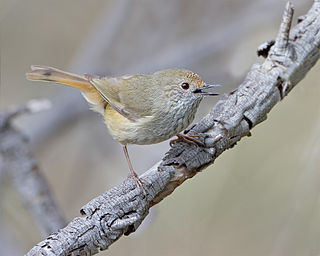
The brown thornbill is a passerine bird usually found in eastern and south-eastern Australia, including Tasmania. It can grow up to 10 cm (3.9 in) long, and feeds on insects. It is brown, grey and white. The species has five subspecies.

The eastern spinebill is a species of honeyeater found in south-eastern Australia in forest and woodland areas, as well as gardens in urban areas of Canberra, Sydney, Melbourne, Adelaide and Hobart. It is around 15 cm long, and has a distinctive black, white and chestnut plumage, a red eye, and a long downcurved bill.

The scarlet myzomela or scarlet honeyeater is a small passerine bird of the honeyeater family Meliphagidae native to Australia. It was first described by English ornithologist John Latham in 1801. At 9 to 11 cm long, it is the smallest honeyeater in Australia. It has a short tail and relatively long down-curved bill. It is sexually dimorphic; the male is a striking bright red with black wings, while the female is entirely brown. The species is more vocal than most honeyeaters, and a variety of calls have been recorded, including a bell-like tinkling.

The white-browed scrubwren is a passerine bird found on the New England Tablelands and coastal areas of Australia. Placed in the family Pardalotidae in the Sibley-Ahlquist taxonomy, this has met with opposition and indeed is now known to be wrong; they rather belong to the independent family Acanthizidae.

The white-cheeked honeyeater inhabits the east coast and the south-west corner of Australia. It has a large white patch on its cheek, brown eyes, and a yellow panel on its wing.

The crimson chat is a species of small bird found in Australia. It is also known as the tricoloured chat, saltbush canary, and crimson-breasted nun.

The forest kingfisher, also known as Macleay's or the blue kingfisher, is a species of kingfisher in the subfamily Halcyoninae, also known as tree kingfishers. It is a predominantly blue and white bird. It is found in Indonesia, New Guinea and coastal eastern and Northern Australia. Like many other kingfishers, it hunts invertebrates, small frogs, and lizards.

The Eyrean grasswren is a small grasswren from the Passerine family Maluridae. This is a cryptically plumaged and uncommon bird endemic to arid regions of Central Australia. The species was discovered by F.W. Andrews in 1874 around the Macumba River at Lake Eyre, and named after the South Australian Surveyor General George Woodroffe Goyder.
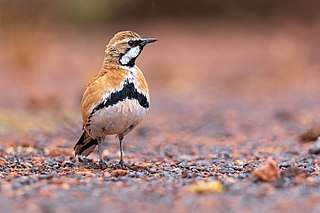
The cinnamon quail-thrush is cryptic arid-zone species that is endemic to Australia. This small to medium-sized species of bird is found in the arid and semi-arid regions of central Australia.

The orange chat is a species of bird in the family Meliphagidae. It is endemic to Australia.
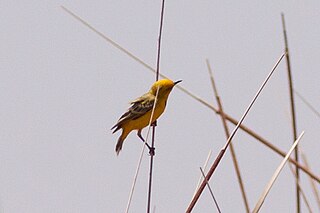
The yellow chat is a small passerine bird endemic to Australia. They are known for their remarkable adaptions that aid their survival in their arid habitat.
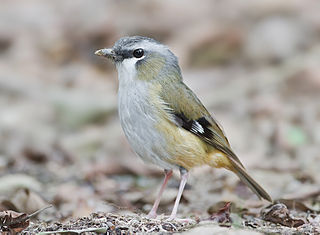
The grey-headed robin is a species of bird in the family Petroicidae. It is found in northeastern Cape York Peninsula.
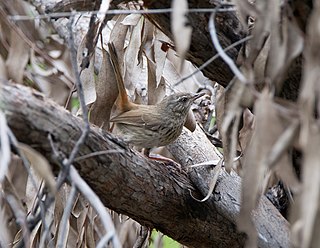
The chestnut-rumped heathwren is a species of bird in the family Acanthizidae. It is endemic to temperate and subtropical forests and heathlands of Australia.
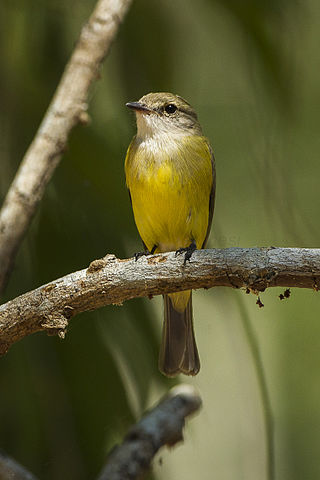
The lemon-bellied flyrobin or lemon-bellied flycatcher is a species of bird in the family Petroicidae. Found in Australia, Indonesia, and Papua New Guinea, its natural habitats are subtropical or tropical moist lowland forests and subtropical or tropical mangrove forests.

The pink robin is a small passerine bird native to southeastern Australia. Its natural habitats are cool temperate forests of far southeastern Australia. Like many brightly coloured robins of the family Petroicidae, it is sexually dimorphic. Measuring 13.5 cm (5.3 in) in length, the robin has a small, thin, black bill, and dark brown eyes and legs. The male has a distinctive white forehead spot and pink breast, with grey-black upperparts, wings and tail. The belly is white. The female has grey-brown plumage. The position of the pink robin and its Australian relatives on the passerine family tree is unclear; the Petroicidae are not closely related to either the European or American robins, but appear to be an early offshoot of the Passerida group of songbirds.
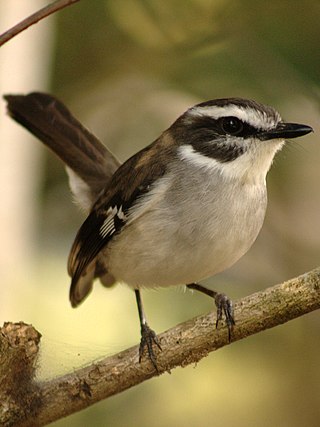
The white-browed robin is a species of bird in the family Petroicidae. It is endemic to north-eastern Australia. Its natural habitats are forest, woodland and scrub, often near water. It formerly included the buff-sided robin as a subspecies.
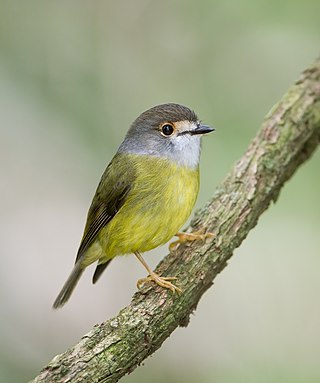
The pale-yellow robin is a species of passerine bird in the family Petroicidae. It is endemic to eastern Australia. Its natural habitat is subtropical or tropical moist lowland forests. It is a nondescript bird with grey head and olive upperparts, white throat and yellow underparts. The sexes are similar. Two subspecies are recognised: the smaller nana from North Queensland, and the larger and uncommon nominate race capito from southeast Queensland and northeastern New South Wales. It is insectivorous.






















